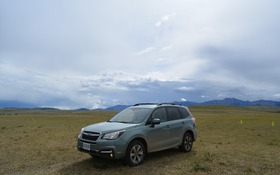2017 Subaru Forester: Subaru is Japanese
A few years ago, Subaru’s advertising campaign was aimed at reminding consumers that they were in fact a Japanese automaker, and not Korean or Chinese, not that there was anything wrong with that…
While on that crusade, Subaru made a big decision to behave more like a Japanese automaker. You see, Subaru grew to fame on a cult-ish level thanks to its different approach to making appliances – their cars had character, quirky designs not to mention performance.
- Also: 2017 Subaru Forester: Keeping up with the Joneses
- Also: 2017 Subaru Forester: Headed to the Rockies for some Fozzy Fun!
Their cars, like the GL10, the Legacy Turbo, the Impreza, the SVX and my beloved bugeye WRX (to mention a few) appealed to few buyers, too few in fact. Then, something happened when Subaru unleashed the Outback, and this was Subaru being itself. The Forester soon followed it and suddenly Subie had landed in the big leagues. They’d become a producer of cars that everybody wanted.
This momentum needed to continue because: selling cars = more money. Subaru made a conscientious choice to extract some of their own design DNA but retain the core of what made them what they were. This is why symmetrical AWD and Boxer engines are always mentioned in their marketing endeavours. If horizontally opposed engine did not catch on, AWD is immensely more common today and this is largely thanks to Subaru.
Once these steps had been taken, the next phase involved refining their principles and ironing out all rough edges. This is where the current generations of the Legacy/Outback and the new Forester come in. Never have Subarus been quieter, more refined but, at the same, more mundane and less exciting. Let’s hope the next generation Impreza and Subaru’s new platform will address this, at least in part.
It certainly seems as though consumers have taken notice as Subaru continues to crush monthly sale records, as well as annual results. Selling appliances has worked wonders for Toyota and Honda but in the process, both brands have retained some of their inherent characteristics. Honda is now returning to its handling roots while Toyota keeps it bland. Subaru blends both aspects and throws in their unique powertrain configuration. And it’s working.
If I’m not enthralled by the trend that dictates that all emotions, feelings and general driver involvement need to be removed from driving, I am happy that Canadians are eating it up. Why? Simple. If Subaru sells boatloads of Foresters, Outbacks and Imprezas, they will continue to build the WRX, STI and BRZ. And that makes ME cheerful!
Subaru’s on the right track, no doubt. In a brief discussion I had with a member of Subaru Canada’s team at the recent 2017 Forester launch, I complained that all the “drama” had been removed from driving their products. The rep jokingly said that he was going to call Japan and tell them to stop what they’re doing. His goal is to sell cars, not please idiots like me that love a challenge when they get behind the wheel of a car.
Although the new Forester is very good, I went to my happy place when I got home to my 2003 bugeye Impreza WRX wagon and went for ice cream with my lovely girlfriend. Keep buying AWD appliances my friends so that I may buy a used 2016 STI in a few years.










